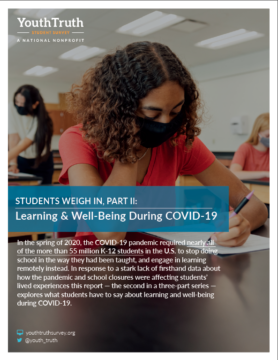Research Report
Students Weigh In, Part II: Learning & Well-Being During Covid-19
- Academic Challenge & Expectations
- Belonging
- Emotional & Mental Health
- Learning Through COVID-19
- Obstacles to Learning
- Postsecondary Planning
- School Culture
Overview
In the spring of 2020, the COVID-19 pandemic required nearly all of the more than 55 million K-12 students in the U.S. to stop doing school in the way they had been taught, and engage in learning remotely instead. In response to a stark lack of firsthand data about how the pandemic and school closures were affecting students’ lived experiences this report — the second in a three-part series — explores what students have to say about learning and well-being during COVID-19.

In July 2020 YouthTruth released Students Weigh In: Learning & Well-Being During COVID-19, a national report that shared insights from more than 20,000 students about their learning and well-being during that first wave of school closures. This initial report was intended to be a one-time, standalone effort.
Yet, students continue to experience a historic period of learning during the 2020-21 school year as the pandemic evolves and they navigate ever-changing conditions in their communities. As a national nonprofit that elevates student voices on critical issues in education, YouthTruth has long asked students about their learning experiences, social-emotional development, and well-being.
To address the need for adults to hear directly from students about how the pandemic is affecting students’ experiences, this second report in the Students Weigh In series explores survey findings from more than half a million secondary students in 952 schools across 37 states during three time periods: pre-pandemic, spring 2020, and fall 2020.
The data, which includes the responses of 62,996 secondary and 22,174 upper elementary students surveyed between September and December 2020, was gathered through a 15-minute online survey, administered in English and Spanish.
-

FINDING 1: Learning Experience
Sixty-one percent of students said they learn a lot every day — up from 39 percent in the spring and on par with pre-pandemic levels — but experiences differ across student groups.
-

FINDING 2: Stress & Anxiety
Feeling depressed, stressed, or anxious has risen to the number one obstacle to learning. Hispanic or Latinx, multiracial, and Black or African American students faced more obstacles on average than did white or Asian students.
-

FINDING 3: Belonging
Sense of belonging recovered from spring 2020, and students experienced increased academic support from their teachers.
-

FINDING 4: Health & Well-Being
Males continued to rate their health and well-being more positively than did females and students who identify in another way. Overall, students reported less availability from adults in school to support their mental and emotional health, but more programs and services.
-

FINDING 5: Spotlight on Seniors
One in four high school seniors’ postsecondary plans have changed since the start of the pandemic.